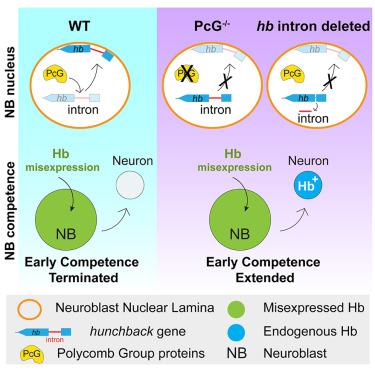Developmental Cell ( IF 11.8 ) Pub Date : 2021-09-15 , DOI: 10.1016/j.devcel.2021.08.020 Tanguy Lucas 1 , Terry L Hafer 1 , Harrison G Zhang 1 , Natalia Molotkova 1 , Minoree Kohwi 2

|
The nuclear lamina is typically associated with transcriptional silencing, and peripheral relocation of genes highly correlates with repression. However, the DNA sequences and proteins regulating gene-lamina interactions are largely unknown. Exploiting the developmentally timed hunchback gene movement to the lamina in Drosophila neuroblasts, we identified a 250 bp intronic element (IE) both necessary and sufficient for relocation. The IE can target a reporter transgene to the lamina and silence it. Endogenously, however, hunchback is already repressed prior to relocation. Instead, IE-mediated relocation confers a heritably silenced gene state refractory to activation in descendent neurons, which terminates neuroblast competence to specify early-born identity. Surprisingly, we found that the Polycomb group chromatin factors bind the IE and are required for lamina relocation, revealing a nuclear architectural role distinct from their well-known function in transcriptional repression. Together, our results uncover in vivo mechanisms underlying neuroblast competence and lamina association in heritable gene silencing.
中文翻译:

离散的顺式作用元件在体内调节发育定时的基因层重定位和神经祖细胞能力
核层通常与转录沉默相关,基因的外周重定位与抑制高度相关。然而,调节基因-纤层相互作用的DNA序列和蛋白质在很大程度上是未知的。利用发育定时的驼背基因运动到果蝇成神经细胞的椎板,我们确定了一个 250 bp 的内含子元件 (IE),这对于重新定位是必要的和足够的。IE 可以将记者转基因定位到椎板并使其沉默。然而,内在地,驼背在搬迁之前就已经被压制了。相反,IE 介导的重定位赋予了遗传性沉默的基因状态,无法在后代神经元中激活,从而终止神经母细胞指定早期出生身份的能力。令人惊讶的是,我们发现 Polycomb 组染色质因子与 IE 结合并且是椎板重定位所必需的,揭示了与它们在转录抑制中众所周知的功能不同的核结构作用。总之,我们的结果揭示了遗传基因沉默中神经母细胞能力和椎板关联的体内机制。


























 京公网安备 11010802027423号
京公网安备 11010802027423号